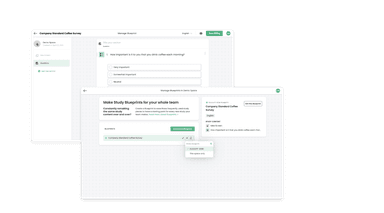Benefits of concept testing
Learning what your target audiences like or dislike about your initial concepts is a challenging task, especially if you lack more advanced research skills and expertise. How should you structure the survey? How do you phrase the questions? What options should you include? That’s what this post is all about - developing concept testing survey questions that work.
Concept testing is an important part of any marketing activity. It’s defined as a process in which ideas are being assessed before a sample group of target consumers. An idea can include anything related to your brand - a flavour, product, packaging design, logo or even pricing and limited time offers.
If you want a refresher on the definition of concept testing, read this post.
When to concept test

When you’re about to launch something new or are reassessing your brand or product portfolio from the ground up, you should always assess the validity of your ideas with target audiences. It helps you determine what your consumers want and how you can tailor your idea to their needs and wants.
There are businesses that nailed their concept executions on the first go, and there are some that didn’t do so well; Dove’s body-shaped shampoo bottles are one example of a failed campaign - the company experienced blacklash on social media due to the alleged misrepresentation of women's bodies. On the other hand, Always’ #LikeAGirl campaign is a great instance when a brand knew exactly what their audience wanted to see and hear. What likely determined the relative success or failure of these ideas was a concept testing survey.

Want to learn why investing in concept testing has an ROI? Check out this case study with Properly, all about how their marketing team tested their messaging to land on the best options for their audiences.
What makes a great concept testing survey?
An well-made concept testing survey is the one that helps you answer the most crucial questions you have about your target audience. If you take the time to develop strong research questions, you are likely to get more reliable responses about your concepts and you’ll have more trust for the insights gathered.
11 best practices for concept testing surveys
1. Focus on the purpose of your study
We understand that you want to know all there is to know about your customer. With this in mind, it might be tempting to continue adding questions to your survey to get more information about the audience. But this might make your survey extremely long and affect respondents’ attention spans and willingness to complete the questionnaire. Therefore, you should always have a set goal in mind when you create your questions. Consider: do these questions all relate back to the goal of the study?
To help you narrow down your field work, think of the end purpose of your study. For instance, when Upsiide ran a study to learn about consumers’ attitudes towards specific on-pack sustainability claims on food and drink products, we wanted to know how people’s beliefs about sustainability affected their purchasing behaviour at point-of-sale. With this goal in mind, we discovered some surprising insights about consumers' attitudes towards sustainability and shopping.
2. The stimulus and format of your questionnaire matters
Are you testing a new package design? Include pictures of the design variations, and add in contextual information as long as it’s useful to the respondent.
Modern survey platforms allow you to experiment with different ways you present the information. So you should make use of those features to create the most engaging experience for the respondents.
3. Set the structure of your questionnaire

A well-structured survey is a key to the success of your concept testing research. When you plan out your questionnaire, consider the respondent experience to improve the readability of your survey.
It’s best to ask broader questions at the beginning of your survey and move to more specific ones afterwards. Make sure to record the demographic details of your respondents such as their gender, age and location - you can place those questions at the end of the survey, or simply include these demographics in the audience targeting at the outset (Most platforms, like Upsiide, have demographics baked in). This way, it’s easier to group and filter the demographic groups at the reporting stage.
4. Consider the order of your questions
The order in which you ask questions can greatly affect the results of your concept testing survey. For example, if you want to know what your audience thinks about a certain topic, it’s best to first ask their opinion in an open-ended question, followed by a multiple-choice question with more options. That way your options won’t influence people’s responses and you will get more accurate data.
Consider the sustainability study we referenced above; while we wanted to understand consumers’ views on sustainability in the context of food & beverage shopping, we made sure to ask questions about their purchasing behaviours and preferences before diving into sustainability questions, so as not to bias their responses.
5. Use simple and direct language
Pick your words wisely, especially if you don’t want to lead your respondents to unclear conclusions. Don't use loaded terms and complicated industry-specific jargon. This will not only confuse the participants, but will also affect the accuracy of the responses.
Long gone are the days of needing to use business-speak and formal language with people responding to your surveys - it’s always best to meet consumers where they are, reflecting their way of speaking back at them.
6. Clarity is the way to go
Be very clear about what you are asking about. What aspect of your product do you want the consumers to evaluate? Is it the appearance, colour palette, shape or functional properties?
The same advice applies to questions about time and cadence. Instead of asking “Do you work out regularly?”, be more specific. In this case, your question could be: “On average, how many days per week do you work out?”.
7. Focus on one thing at a time
‘Double-barrelled’ questions are a common mistake among many first-time survey writers. Asking a question like "Do you think the packaging is colourful and informative?" is an example of a double-barrelled question - it asks respondents two different things at the same time. What if you think the packaging is colourful, but not informative?
Your question needs to focus on one thing at a time to ensure accurate answers from respondents.
8. Avoid leading questions
Leading questions are questions that are framed in a way that forces a respondent to provide a specific or ‘guided’ answer. A leading question might be “Are you in favour of the gun control policies?”. A better way of phrasing this question would be “How do you feel about gun control policies?”. The former wording might make a respondent more likely to indicate that yes, they are in favour of gun control, while the latter question is asked in a neutral way, giving people a number of options to choose from.
When writing a concept testing survey, you might know how you’d like people to respond. But it’s crucial to phrase your questions in a way that allows respondents to elicit truthful answers. To bring an objective perspective to your research, show your concept testing questionnaire to other people around the organization - they can help you identify where your question might be leading to a specific outcome.
9. Choose answer options carefully
It's easy to fall into the trap of bias. This can happen when a question doesn't provide a balanced set of answer options.
Let's say one of your product testing questions reads "To what extent to you agree with this statement?". Your answer options might include:
Strongly agree
Agree
Somewhat agree
Or, your answer options might be:
Strongly agree
Somewhat agree
Somewhat disagree
Strongly disagree
In this example, can you see why the first set of answers might not allow you to capture truthful responses? Always make sure to give respondents the opportunity to express their opinion with a more balanced set of options (like in the second example).
10. Consider the answer options you include
Participants don't always have strong opinions on either side of the spectrum. So it's a good practice to include a "neutral" option in answers. "Neither agree nor disagree" or "N/A" are some of the ways you can incorporate this option.
Sometimes, however, respondents might have more things to say. If your set of answer options doesn't have an option they want to choose, always add an "Other" option.
It's best, of course, if your questions feature robust and varied responses. Research possible answers in advance and collaborate with your colleagues to identify other choices you might have missed.
11. Try not to psych yourself out!
When you’re not a “researcher” it can be a little bit scary to craft your own survey from scratch. Luckily, research technology and concept testing templates are on-hand to help you get started in the easiest, most trustworthy way possible. Remember, the hardest part of doing a concept testing survey is just getting started!

Upsiide offers Templates for this exact purpose - learn more by connecting with one of our experts.
To conclude
You're all set to write an effective concept testing survey!
A final thought to leave you with: test your survey before launching it. Ask your friends, family and colleagues to run through the questions and give their honest feedback - you can't imagine how helpful it is to have a fresh pair of eyes looking at your questionnaire. The more feedback you receive, the better your questions become and the more accurate results you’re likely to get.




